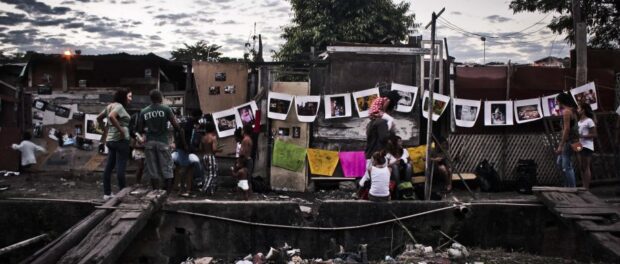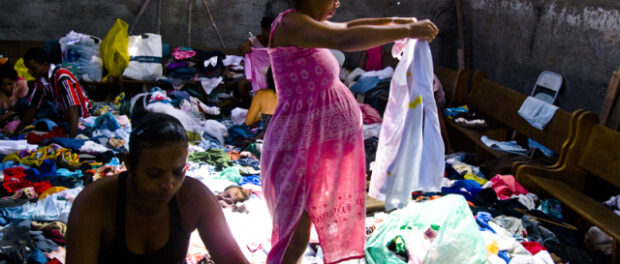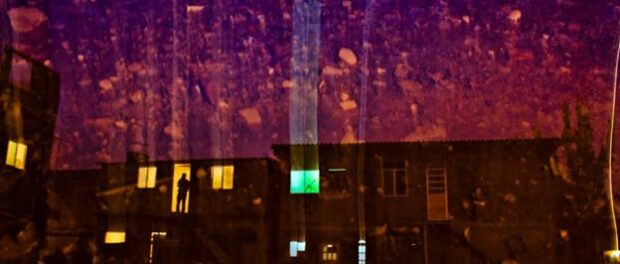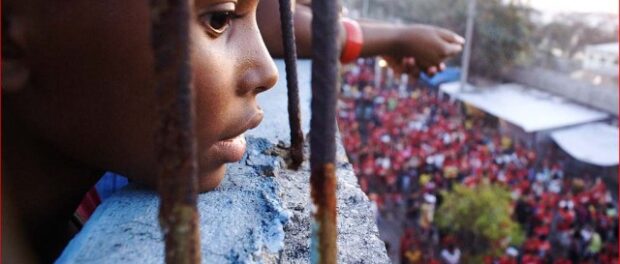
When Germany celebrated the 25th anniversary of the fall of the Berlin Wall on November 9, the date meant something different to the members of Favela em Foco (Favela in Focus). It marked the five year anniversary of the multimedia collective’s founding. The unexpected connection between the two events is highlighted in the group’s first project, a short film titled “O Muro de Berlim é aqui?” (“The Berlin Wall is Here?”), which was released in November 2009 at the time of the 20th anniversary of the wall’s fall. The film draws parallels between divided Berlin and the walls that were being built along Rio’s Red Line and Yellow Line highways. These walls restricted access from the roads to the favela complexes surrounding them, sparking questions as to whether the government genuinely intended to reduce the noise experienced by residents, as it claimed, or wanted instead to hide the favelas from the road.
The birth of Favela em Foco represented a dream come true for its founders, who had been drawing plans for two years. In 2007, the Observatório de Favelas, based in the favelas of Maré, offered photography workshops to some of Jacarezinho favela’s young residents. Enthralled by the prospect of documenting daily life in their community, several participants created a project called Jacarezinho em Foco, using photos, videos, and blogs to tell local stories. They received funding amounting to R$3,000 and dreamed about starting a community magazine. After only two months and the publication of just one magazine issue, however, it became clear that a print magazine could not be sustained without continued funding.
While some participants had to abandon the project to commit time to paying jobs, a few members remained committed to establishing a community-led media project. Realizing that an online platform offered a far more affordable and flexible alternative to print, the Favela em Foco collective emerged with a WordPress website as its central platform, supplemented by Facebook and Twitter.

As the name of the collective suggests, this transition also expanded the collective’s focus from Jacarezinho to favelas across Rio de Janeiro. Currently, the collective has seven Rio-based members, photographers from Jacarezinho, Complexo do Alemão, Bonsucesso, and Maré, all in Rio’s underserved North Zone. Members do not limit their work to their own communities or even the North Zone, covering events across the city, from Vila Autódromo in the West Zone to Niterói and Nova Iguaçu in the greater metropolitan region. This past year, the collective has covered topics including protests during the World Cup, Pacifying Police Unit occupations, the trash collectors’ strike, and traditional Afro-Brazilian religious celebrations. Reports combine stunning and sensitive photography with short texts explaining the situation portrayed.
Léo Lima, one of the founding members, explained that wherever members of the collective work, their coverage of events or stories differs dramatically from that of mainstream media because they spend more time on the ground. He said: “A tragedy happens and everybody goes–all the media outlets and the collective. They go, they stay, and after it’s over, everyone else leaves while the collective stays.” From his perspective, this is a key role of community and alternative media: to understand and work with communities to tell the story. Luiz Baltar, a fellow member of the collective, agrees. When asked about the role of community media he replied: “It is to document the struggles and daily life while giving visibility and support. It is to do this with, not for, [communities].”
Favela em Foco’s structure and planning is informal and loosely organized. In an interview Lima laughed as he recalled how he trekked out to Vila Autódromo to cover an event, only to find that others from the collective were already there. He explained that there is little need for a strict division of tasks, although he does take responsibility for uploading content to the blog and Facebook page. Nor are there regular meetings or a rigid editorial line. Individual members are given flexibility to explore the topics that interest them. Baltar wrote that he began contributing to the collective in 2012 with materials related to forced evictions and the struggle for housing. Since officially joining the collective earlier this year, he has continued to pursue these subjects and feels that individual initiatives do not conflict with the group’s needs but, instead, support them, enhancing the quality of the collective work.
What draws the collective together is a focus on favelas, popular or public spaces, and marginalized populations, with the goals of giving visibility to unheard perspectives and challenging stereotypes. Lima admitted he is not sure they can change the stereotypes and stigma that have formed over decades. Rather than fretting on what seems like an insurmountable challenge, however, he focuses on growing the variety of stories and perspectives that are shared, building evidence to counter the idea that there is a single favela experience, or a single favela perspective. He pointed out the absurdity of someone suggesting that everyone in the South Zone can be described uniformly, while noting that the mainstream media has been guilty of trying to describe favela residents in this way. He even pushed back against people who want to “promote favela culture,” arguing that there is not just one but “various cultures.”
When asked about the challenges facing the collective, both Lima and Baltar mentioned continued difficulties with funding. Lima reflected that to produce quality work demands a lot of time and that, without financial compensation, this demands that members have “great passion.” For now though, they will celebrate reaching five years and continue to press forward with ongoing projects, which include explorations of the right to childhood and the impacts of the upcoming Olympic Games.
For more information, visit Favela em Foco’s website, or follow the collective on Facebook or Twitter.



